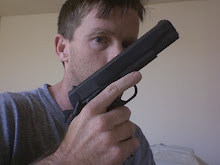Via Michael Bane, we have this:
This notification is to inform Industry the Combat Pistol requirement is postponed indefinately. USSOCOM will no longer issue a Request for Proposal.
So it looks like for the time being, the military is going to keep using the sidearm they've been using since 1985, the 9mm Beretta M9. Far be it from me to weigh in on the 9mm vs. .45ACP debate, but Mr. Bane had this to say, and I think it's safe to say he knows much more than I do about the merits of what our troops have to work with:
...the bureaucratic collapse of the SOCOM RFP is going to cost AMERICAN LIVES! Here's how...yeah, the operators get what they want...but there's a lot of guys out there who aren't the operators...and they're still doing the job with what they have on hand. They're the men and women driving the Humvees and the trucks, working support roles, ect. THEY are the ones who wanted a better handgun, because they're the one's who most often need what a handgun does — one-handed firepower up close and personal.
When your butt is sandwiched into a Humvee, the SHTF and one hand has to remain on the wheel so you can get the operators out, what do you want in your free hand? I submit that the answer to that question is NOT a flawed 9mm loaded with ball.
You want a .45 that goes BANG every single time, because that's what's going to get you and the people in that Humvee or truck HOME!
And now those poor bastards are not going to get that .45 because some behind-the-line clerks couldn't decide on whether the guns should be optionally available in pink with racing stripes or some other lame requirement.
It's a damn crime, and, as usual, the grunts in the field are going to pay the price!
I think it would be interesting to see just how many American lives have been lost because they had the 9mm instead of the .45. Personally, I wouldn't want to get hit with either of them, but the fact is that the .45, in tandem with the Model 1911 pistol, has a pretty illustrious track record as the government-issued sidearm-ammunition combination of American troops over the years, does it not? WWI, WWII, Korea, Vietnam...say what you will, but John Moses Browning must have been doing something right. This is all just my unenlightened opinion, of course. And so is this: The change to the 9mm was a fixing of something that was not broken, a catering to, literally, the lowest common denominator -- or, if you will, the smallest. Instead of our NATO allies making the change to the bigger bullet, we made the change to the smaller one. Perhaps that was logistically the easier thing to do, but was it really the smartest? As Tim Chandler said,
Certainly a 9mm weapon that can hold 15 rounds in the magazine and one in the chamber has greater CAPACITY than the 7+1 round .45 caliber pistol, but whether or not that translates into greater "firepower" is a matter of debate. (Is it better to hit someone with 3 puny rounds, or 1 round that knocks them out of the fight?)
It's a point worth considering, notwithstanding the arguments for the M9 -- what some might call a safer manual of arms: DA/SA/safety as opposed to single-action, cocked-and-locked, lighter recoil of 9mm for smaller shooters, etc. -- and this leads to another couple of points.
There are those who say that the police and the military are the only ones professional enough to handle guns. How interesting it is that others will argue these same professionals would be better off not having to master the manual of arms of something like a 1911. I shot single/double-action pistols for a good year before I picked up a 1911, and it took me maybe a day to figure the 1911 out. Of course, I fanatically followed the Four Rules, but one should be doing that no matter the manual of arms of their weapon.
Many say the 1911 is not the best gun for a beginning shooter, and perhaps it isn't, as a double-action pistol with the longer trigger pull allows for slightly more room for error, and no doubt a beginner would find the cocked-and-locked position more than a little intimidating. As with all matters involving firearms, though, the more familiar people get with their weapons, the intimidation factor arguably does go down. So there's, to my mind, one more argument for the civilian possession of arms -- if they're familiar with them going in, it would make for easier training, at least a little. Better for people to know as much going in as they can, I think...


|